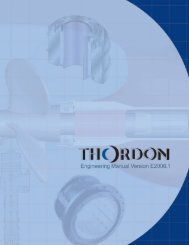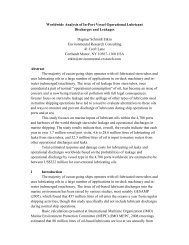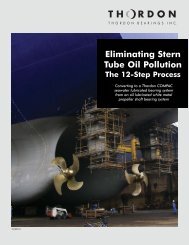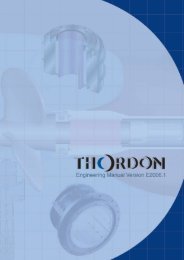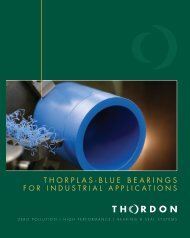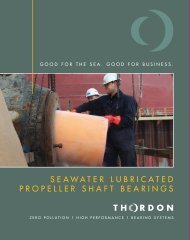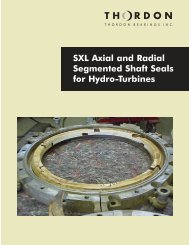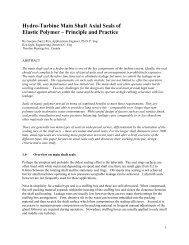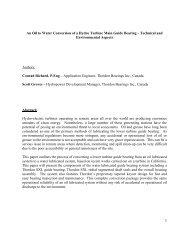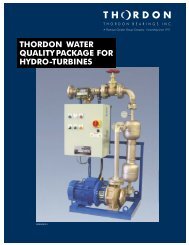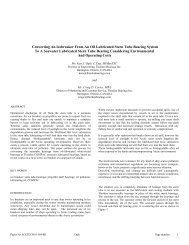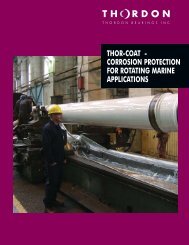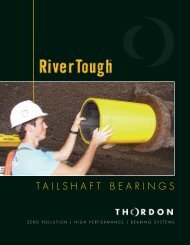Oil Lubricated Stern Tube Discharges - Thordon Bearings
Oil Lubricated Stern Tube Discharges - Thordon Bearings
Oil Lubricated Stern Tube Discharges - Thordon Bearings
Create successful ePaper yourself
Turn your PDF publications into a flip-book with our unique Google optimized e-Paper software.
OIL LUBRICATED STERN TUBE DISCHARGES:<br />
THE PROBLEMS AND THE SOLUTION
WHAT IS STERN TUBE LUBRICATING OIL AND WHY IS IT AN ISSUE?<br />
Currently, the majority of commercial ocean-going ships operate with a propulsion system using a propeller<br />
shaft typically supported by oil lubricated white metal bearings with the oil contained in the stern tube by shaft<br />
seals. This “sealed stern tube system” is filled with mineral oil and sealed typically with a forward and aft lip<br />
type seal at each end as shown in Figure 1. Typical stern tubes contain 1500L (396 US gal) of mineral oil. The<br />
white metal stern tube bearings in a sealed oil system, provide for predictable and controlled wear life of the<br />
shaft bearings. This system has been in use since the 1950’s when it replaced seawater lubricated wood<br />
(lignum vitae) bearings where wooden bearing wear life was unpredictable and corrosion prevention was an<br />
issue.<br />
Figure 1. A typical oil lubricated stern tube bearing system<br />
However, there are some issues with an oil lubricated stern tube bearing system and the issues have become<br />
much more prevalent today with concerns over any ship source pollution.<br />
Operational Discharge<br />
The two shaft seals containing the oil require frequent maintenance or oil will leak into the sea or into the<br />
ship. <strong>Stern</strong> tube seal oil leakage from a ship is considered “normal operational consumption” and typically<br />
an acceptable practice. According to seal manufacturers, the seal must leak (aft-into the sea or forward-into<br />
the ships bilge) at the shaft/seal interface in order for the seal to function properly.<br />
Wartsila Propulsion (<strong>Bearings</strong> & Seals), UK<br />
“<strong>Oil</strong> consumption from the seal is controlled to the minimum acceptable to maintain an acceptable life,<br />
but by design it is essential to have oil at the mating surfaces.”<br />
“<strong>Oil</strong> consumption is always lost direct to the sea so contaminating the environment.”<br />
“The best estimates that can be made can only be based on seals in a lab condition running in clean<br />
and controlled environments but even this indicates an excess of 10,000,000 liters/year of oil is lost.<br />
Many organizations predict far higher in reality but difficult to prove with facts.”<br />
Higgenbottom, Adrian. Wartsila Propulsion (<strong>Bearings</strong> & Seals) UK, “Coastguard Non-Polluting <strong>Stern</strong> tube Sealing System,” presented<br />
at the RINA International Conference for the Design and Operation of Container Ships, 23-24 April 2003, London, UK , pp 53-60.<br />
KEMEL, Japan<br />
“In stern tube bearings, the radial movement of the shaft is considerably larger than that of bearings for<br />
general industrial application. In addition, external disturbances such as rough seas and vibration are<br />
considerable. It is practically impossible to seal the stern tube oil perfectly. Therefore, one of the serious<br />
environmental issues in medium and large commercial vessels is stern tube oil leakage.”<br />
Sada, Hiroyuki, Seiji Yamajo, David W. Hawkins and Tsuyoshi Kawazoe. Kobelco Eagle Marine Engineering Co. Ltd., Japan, “An<br />
Environmentally Compatible Lubricant for <strong>Stern</strong> <strong>Tube</strong> Shafting and Bearing Systems,” presented at the 11th Shafting Symposium of the<br />
Society of Naval Architects and Marine Engineers, Sept. 12-12 2006, Williamsburg, VA, U.S.A., pp 1.<br />
1
Accidental Discharge<br />
Ships operate all over the world in oceans, seas, lakes and harbours and propeller shafts are prone to come<br />
in contact with fishing line, net, rope, garbage, ice and even damage to a propeller by hitting the bottom. A<br />
simple fishing net or rope caught on a ships rotating shaft as shown in Figure 2 can damage the aft seal<br />
allowing stern tube oil to flow out into the sea or seawater to flow inboard contaminating the lubricating oil.<br />
The seals also wear over time allowing more oil to be discharged - seal manufacturers claim drip free<br />
operation of 2500 hours or 2 years, whichever comes first for replacement of seals. A typical commercial<br />
ship will operate 6000 – 8000 hours per year and drydock the ship 2.5 to 5 years for seal maintenance.<br />
Lloyd’s Register reported:<br />
“Defect statistics over the last 20 years indicate that the aft stern bush represents 10% of shaft line failures, with<br />
the forward stern bush representing 4% of total failures. Interestingly, the aft stern gland (seal) and forward<br />
stern gland (seal) represent 43% and 24% of failures respectively.”<br />
Smith, Andrew, Lloyd’s Register Global Technology Leader-Engineering Systems., “Shaft Alignment Problems Analyzed,” Marine<br />
Engineers Review April 2009, pp. 16<br />
Figure 2: Rope tangled around propeller shaft causing seal damage<br />
According to Emergency Seal Repair companies, this occurs on a frequent basis as reported in Ship Repair<br />
Newsletter published weekly by: A&A Thorpe, U.K., from 2007 to 2011, Issues 1108, 1117, 1121, 1126,<br />
1127, 1162, 1171, 1182, 1196, 1207, 1227, 1306, 1307, 1318, 1332, 1334, 1342, 1345 and 1355.<br />
HOW MUCH OIL IS BEING DISCHARGED?<br />
A recent independent study done by a New York consulting firm showed that,<br />
“Total annual inputs of lubricating oil worldwide from stern tube leakage into port waters is estimated to be<br />
between 37 million to nearly 61 million litres. If the same rates of discharge occur at sea as they do in port, the<br />
estimated worldwide annual inputs of lubricants to marine waters both in ports and harbours and at sea might<br />
be estimated to be about four times the port estimate. Thus, total worldwide use of stern tube lubricants from<br />
operational leaks and discharges would then be about 130 million to 244 million litres annually. “<br />
Etkin, Dagmar Schmidt. Environmental Research Consulting “Worldwide Analysis of In-Port Vessel Operational Lubricant ,” Arctic and<br />
Marine <strong>Oil</strong> Spill Program Technical Seminar of Environment Canada, 8 June 2010, Halifax, Canada<br />
A directive from the European Maritime Safety Agency (EMSA) of the European Union is to use satellite<br />
imagery to detect oil spills. The EMSA Bulletin 2009 CleanSeaNet noted that in an 18 th month period from<br />
2007 to 2008:<br />
“4,027 possible oil slicks were detected and reported to the authorities. The percentage of CleanSeaNet<br />
detections checked on site by aircraft or vessels confirmed as being mineral oil may vary from one region to<br />
the other but can reach values as high as 80%.”<br />
Marc Journal, European Maritime Safety Agency Bulletin 2009 CleanSeaNet: Satellite-based monitoring service for marine oil spill<br />
detection and surveillance in European waters, pp 48-51<br />
2
Figure 3. North Sea CleanSeaNet oil slick detections via satellite in 2008<br />
Most slicks are detected by CleanSeaNet along the main maritime traffic routes in Europe as shown in Figure<br />
3. This indicates that illegal discharges from ships are still an important source of pollution that causes<br />
significant damage to the marine and coastal environment.<br />
Most ship owners and operators believe stern tube oil leakage is minimal and consider the oil lost as “normal<br />
operating consumption”. The only true numbers for stern tube oil leakage can be gained from those ship<br />
owners and operators who are also spending money on oil to keep their stern tube in working order.<br />
WHAT ARE THE CONSEQUENCES OF STERN TUBE LUBRICATING OIL<br />
DISCHARGES FOR SHIP OWNERS AND OPERATORS?<br />
First and foremost, stern tube lubricating oil discharges cost ship owners and operators money. Typical<br />
emergency seal repairs to fix/replace a leaking seal can be up to US$200,000. They can’t afford to leak oil<br />
as pollution and the preservation of the environment are big concerns for the shipping industry. A<br />
growing number of new environmental regulations are being considered and enacted by a number of<br />
countries, particularly the United States, Canada and the European Union.<br />
U.S.A.<br />
Clean Water Act<br />
The Clean Water Act requires that any spill or discharge that results in a sheen on the navigable<br />
waters in the contiguous zone (24 nautical miles from baseline) of the United States, be immediately<br />
reported to the National Response Center by telephone (1-800-424-8802) or other means.<br />
<strong>Oil</strong> Pollution Act of 1990 (OPA ‘90)<br />
The OPA’90 established limits of liability for cleanup costs and damages to be paid by responsible parties in<br />
oil spills. However, because of the availability of strict liability criminal sanctions as well as criminal sanctions<br />
for simple negligence under United States laws for spills in United States navigable waters, vessel<br />
crewmembers and corporate officers of corporations that own or operate vessels face potential criminal<br />
liability for practically any oil spill. This is true even when the spill is small or the resulting environmental<br />
damage is minor.<br />
Polluters pay. The responsible party (the owner, operator or charterer of a vessel) must pay for the cleanup<br />
within certain liability caps. Parties that fail to notify the proper authorities of a spill are now subject to greater<br />
fines and longer prison terms. Civil penalties have also been toughened, with the owner of a vessel or facility<br />
that discharges oil or a hazardous substance liable for up to $37,500 a day in fines.<br />
National Pollutant Discharge Elimination System (NPDES) Vessel General Permit (VGP) for<br />
<strong>Discharges</strong> Incidental to the Normal Operation of Vessels (Dec. 18, 2008)<br />
3
The NPDES Vessel General Permit is issued pursuant to EPA’s authority to issue permits under Clean Water Act<br />
Section 402. Clean Water Act Section 402 and its implementing regulations contain standards that govern<br />
EPA’s imposition of NPDES permit conditions. The regulations cover 26 separate types of discharges-including<br />
some never before covered. Vessel owner/operators often use lubricants to maintain the functionality and<br />
structure of equipment such as wire rope and other mechanical equipment. As a requirement of this permit,<br />
vessel owner/operators must apply lubricants and maintain all seals so that discharges do not result in a<br />
visible sheen or are otherwise harmful.<br />
They create new reporting requirements and carry "extensive" civil and criminal penalties for violations,<br />
including jail time. Violations can carry "extensive" civil and criminal penalties. These may include fines of up<br />
to $37,500 a day for each violation per vessel. Some violations carry jail sentences and could lead to<br />
debarment from federal contracts.<br />
Penalties resulting from violations of federal, state or local environment laws in the United States come in<br />
many forms – criminal (such as fines or jail terms), civil (such as civil and judicial penalties) and administrative<br />
(such as loss of government contracts or permits). Additionally, there can be other adverse reactions such as<br />
bad public relations or insurance problems. Environmental enforcement remains one of the few areas in<br />
which government resources continue to GROW rapidly. Strict liability criminal statutes in the US applying to a<br />
large number of oil spills and other vessel source pollution incidents greatly increases the risk of potential<br />
criminal liability for these incidents. Even when environmental statutes require that the government prove intent<br />
or negligence in criminal prosecutions, the standard of intent or negligence is minimal.<br />
Canada<br />
In Canada, when an oil slick is detected within the Canadian 200-mile exclusive economic zone and a ship is<br />
suspected of being the source of the slick, MARPOL can be enforced. Under current Canadian legislation, oil<br />
polluters can be charged under the Canada Shipping Act (CSA), the Migratory Bird Convention Act (MBCA),<br />
the Canadian Environmental Protection Act (CEPA), and the Fisheries Act (FA). Dozens of reports concerning<br />
offshore oil pollution are received by Transport Canada and Environment Canada every year. Enforcement<br />
officers and pollution prevention officers (PPOs) are empowered to turn a ship back to any port to allow<br />
further investigation, and to detain the ship once it arrives in port.<br />
The new Bill C-15 raised the maximum fines in the MBCA for illegal releases of harmful substances into areas<br />
frequented by migratory birds from $100 000 to $300 000 for a summary conviction and from $250,000 to<br />
$1,000,000 for an indictable offence.<br />
European Union<br />
International laws require enforcement:<br />
1) MARPOL ANNEX 1<br />
2) The European Union Directive on “Ship Source Pollution” [EU/2005/35]<br />
• The EU parliament claimed “that member states shall take the necessary measures to achieve or maintain<br />
good environmental status in the marine environment by the year 2020 at the latest”<br />
• The OSPAR Commission called to “move towards the target of cessation of discharges, emissions and<br />
losses of hazardous substances by the year 2020.<br />
Directive 2005/35/EC on ship-source pollution and on the introduction of penalties for infringements<br />
addresses the punitive side of non-compliance with MARPOL. It reproduces the MARPOL standards and<br />
provides that any intentional or seriously negligent infringement of those standards, whether in the coastal<br />
waters of the Member States or on the high seas, shall be effectively dealt with by EU Member States. (Marpol<br />
73/78 discharge regulations relating to discharges of oil and noxious liquid substances, as referred to in<br />
Article 2.2).<br />
MARPOL 73/78 legally recognized that certain sea areas have particular oceanographic and ecological<br />
characteristics, as well as conditions of sea traffic, that make them particularly vulnerable to ship-source<br />
4
pollution and that therefore warrant a need for a higher level of protection. The Convention therefore<br />
introduced a special regime applicable to Special Areas (including Mediterranean sea, Baltic sea, Black sea<br />
and Northwest European waters), wherein more stringent standards would apply to the discharge of<br />
substances regulated in the different Annexes. In Special Areas under Annex I all discharges of oil or oily<br />
mixtures are by and large prohibited to almost undetectable levels, except for minor and well-defined<br />
exceptions (safety of life emergencies). All ships operating in the Special Areas have to be fitted with special<br />
equipment (e.g., oil separation equipment or filters), and must retain oil residues that cannot be discharged<br />
into the sea or discharge these residues at designated port reception facilities.<br />
By requiring EU Member States to implement effective, proportionate and dissuasive penalties for<br />
infringements of the MARPOL rules, the Directive provides an additional disincentive for ship operators and<br />
others to pollute the seas. Directive 2005/35/EC also calls for the development of an information system to<br />
ensure its effective implementation, and for common practices and guidelines for the monitoring and early<br />
identification of ships engaged in unlawful discharges.<br />
The European Union and its Member States are continuously monitoring European coastal waters with the<br />
objective of spotting pollution incidents and identifying the polluters. The monitoring is done by using surface<br />
vessels, surveillance aircraft and remote sensing satellites. These capabilities are improving all the time,<br />
although much still needs to be done before they are able to provide a fully comprehensive, consistent and<br />
reliable picture of pollution in EU waters. Via Directive 2005/35/EC, EMSA is involved in the development of<br />
technical solutions and in the provision of technical assistance in relation to the implementation of the<br />
Directive. This includes actions such as tracing discharges by satellite monitoring, and the EMSA CleanSeaNet<br />
system now supplies satellite images and information on pollution to Member States. CleanSeaNet has<br />
become an important part of the pollution monitoring network and is continually improving its capabilities.<br />
OSPAR Convention<br />
OSPAR is the mechanism by which fifteen Governments of the western coasts and catchments of Europe,<br />
together with the European Community, cooperate to protect the marine environment of the North-East<br />
Atlantic. The fifteen Governments are Belgium, Denmark, Finland, France, Germany, Iceland, Ireland,<br />
Luxembourg, The Netherlands, Norway, Portugal, Spain, Sweden, Switzerland and United Kingdom.<br />
The polluter pays principle is one of the central guiding principles of the OSPAR Convention and requires that<br />
the costs of pollution prevention, control and reduction measures must be borne by the polluter. The polluter<br />
pays principle is mainly implemented by means of command-and control approaches but can also be applied<br />
via market-based mechanisms, e.g. for the development and introduction of environmentally sound<br />
technologies and products. Recognised by the ministerial North Sea Conferences in 1984, the polluter pays<br />
principle was included in the 1992 OSPAR Convention. Internationally the polluter pays principle was<br />
introduced in the 1970s by the Organisation for Economic Co-operation and Development (OECD) and<br />
reaffirmed globally in the 1992 Rio Declaration on Environment and Development.<br />
CAN STERN TUBE LUBRICATING OIL DISCHARGES BE ELIMINATED?<br />
Two options claim to reduce stern tube oil pollution by using environmentally friendly variations on the<br />
standard oil lubricated white metal bearing system.<br />
1) Seal manufacturers have developed more sophisticated multi lip seals which reduce the amount of oil<br />
that escapes, but shaft seals can still be damaged, oil can still escape into the sea and owners still have<br />
to deal with any oil captured onboard.<br />
2) Biodegradable oils are also available, but they are still considered a pollutant and leave a sheen which<br />
must be reported when leaked.<br />
These two options are advertised and perceived by many as a solution to oil discharges, but the reality is that<br />
5
they are just a variation of the same oil leakage problem.<br />
One simple option exists that completely eliminates stern tube oil pollution. Using seawater lubricated<br />
<strong>Thordon</strong> non-metallic bearings in place of oil and white metal. The seawater is taken from the sea, pumped<br />
through the bearing positions and then flows to the sea as shown in Figure 4. No stern tube oil is needed.<br />
<strong>Thordon</strong> designs and manufactures non-metallic bearing materials that offer performance similar to oil<br />
lubricated bearings. Lower in service costs are also achieved with the elimination of the aft seal, oil and<br />
associated maintenance, along with no aft seal damage worries or oil pollution risk.<br />
Figure 4. <strong>Thordon</strong> seawater lubricated stern tube bearings<br />
Research presented at a recent RINA (Royal Institute of Naval Architects) conference noted the benefits of<br />
seawater lubricated propeller shaft bearings:<br />
“Traditionally, the shaft line is oil lubricated, and located inside the tube case with a diameter larger than the<br />
shaft itself. An alternative solution is presented with water lubrication, which offers some consequent benefits.<br />
First of all, the inflow water meets a smaller diameter and so the wake peaks on the propeller plane are<br />
reduced. Furthermore, the water through frictional effect is trailed in rotation towards the propeller with a<br />
significant benefit for propulsion efficiency (about 2%). The water lubricated shaft line is also practically<br />
maintenance free and represents a ‘green’ solution as the risk of oil leakage is avoided.”<br />
G. Lavini & L.Pedone, Fincantieri Cantieri Navali Italiani SpA, Italy, “Improvement on Hydrodynamic Performance of Conventional<br />
Passenger Ship Hulls Through RANSE Codes Application,” presented at RINA’s Design and Operation of Passenger Ships, part of<br />
Cruise & Ferry Conference, April 25, 2007.<br />
Over 2000 ships use seawater lubricated stern tube bearings with zero<br />
risk of oil discharge<br />
Currently, there are over 2000 ships operating with <strong>Thordon</strong> seawater lubricated stern tube bearings with the<br />
6
first commercial ship installation in 1983. Some references are presented below:<br />
• Carnival Corp. (U.S.A.) - 14 cruise ships (32,000 to 115,000 GT) first delivered in 1998; 2 on order<br />
• BP Shipping (U.K.) – 4 tankers (193,000 DWT) since 2004<br />
• Flinter Groningen BV (Netherlands) - 28 dry cargo ships (4,000 to 9,000 DWT) first delivered in 2002;<br />
• Gypsum Transportation (U.S.A.) - 2 bulkers (50,000 DWT) delivered 2001 and 2009<br />
• COSCO - China Ocean Shipping Group (China) - 3 car carriers (56,000 GT) and 10 bulk carriers<br />
(32,000 DWT)<br />
• Scanscot Shipping (Germany) – 4 heavy lift cargo ships (9500 DWT) first delivered in 2009<br />
• Algoma Corp. (Canada) - 5 bulkers (18,000 to 31,000 DWT) first delivered in 1999<br />
• BC Ferries (Canada) - 5 ferries, first delivered in 2003<br />
• Interlake Steamships (U.S.A.) - 6 bulkers (24,500 to 69,172 DWT) since 1999<br />
• Oceania Cruises (U.S.A.) - 2 cruise ships (65,000 GT) since 2011<br />
• Palmali Shipping Group (Turkey) - 10 product tankers (8,000 to 13,000 DWT) since 1999<br />
• New York City Staten Island Ferries (U.S.A.) - 3 ships (5,900 GT) since 2004<br />
The U.S., Canadian and Indian Coast Guard (oil pollution enforcement agencies) also use <strong>Thordon</strong> seawater<br />
lubricated stern tube bearings on over 65 of their ships with the first installation in 1983.<br />
The world’s largest cruise ship operator, Carnival Corporation through its operator Princess Cruises, has<br />
COMPAC seawater lubricated propeller shaft bearings currently installed on 14 of their ships with 2 more on<br />
order. Mr. Chris Joly, Principal Manager, Marine Engineering for Carnival Corporation recently stated,<br />
“Seawater lubricated bearings are the present for many of our ships; I would like to see them for all of our<br />
future ships. In the <strong>Thordon</strong> COMPAC bearing, clean seawater is pumped to the ‘A’ bracket and the aft stern<br />
boss bearings as the lubricating medium and it flows through the bearings to the sea. No aft oil seal and no<br />
oil means lower in-service costs of the shaft line and, as important, no pollution worries. The added<br />
advantage is that the COMPAC tapered key system allows inspection of the bearing and shaft journal without<br />
pulling the shaft. To date, our experience is that COMPAC bearings with Inconel journals will mean worry free<br />
shaft lines for the life of the vessel.”<br />
Sources:<br />
Environmental Criminal Liability in the United States: A Handbook for the Marine Industry published by the Chamber<br />
of Shipping of America, 1730 M Street, NW, Suite 407,Washington, DC 20036-4517<br />
www.marisec.org/pubs/pubslist.htm<br />
Kees (C.J.) Camphuysen. Royal Netherlands Institute for Sea Research, Chronic oil pollution in Europe.<br />
www.ifaw.org<br />
Murray, David. Waterways Journal, January 19, 2009, pg. 3,20<br />
U.S. Environmental Protection Agency. 2008 Final Issuance of National Pollutant Discharge Elimination<br />
System (NPDES) Vessel General Permit (VGP) for <strong>Discharges</strong> Incidental to the Normal Operation of<br />
Vessels. Fact Sheet. Dec. 18, 2008<br />
www.ospar.org<br />
Published: August 26, 2011<br />
3225 Mainway Drive, Burlington, Ontario L7M 1A6 Canada<br />
Tel: +1.905.335.1440 Fax: +1.905.335.4033 www.<strong>Thordon</strong><strong>Bearings</strong>.com



